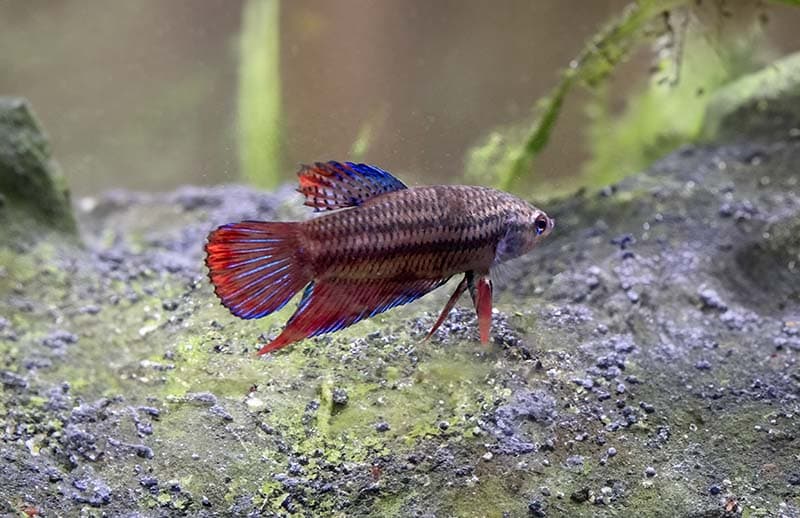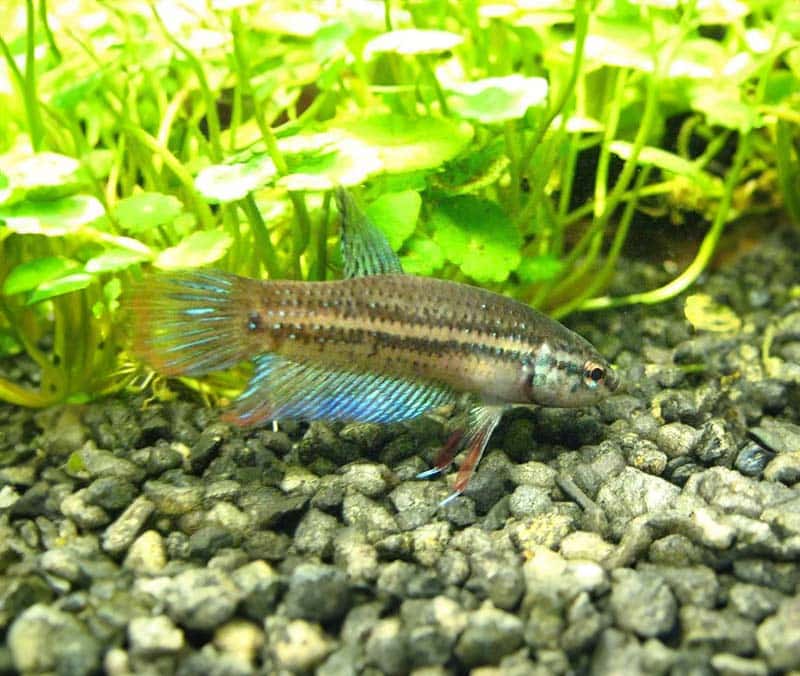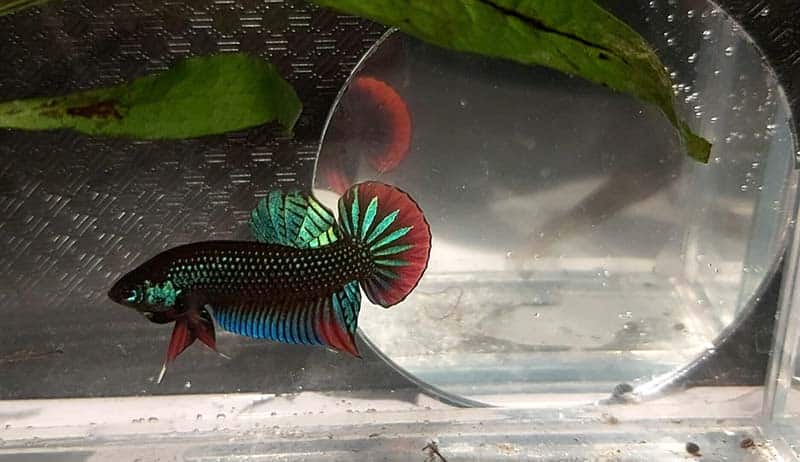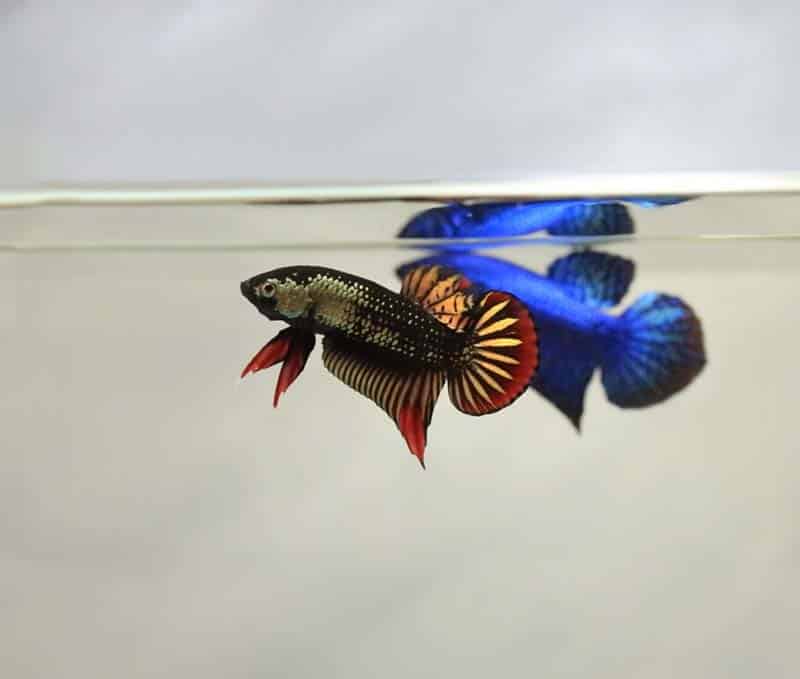Betta imbellis, commonly known as the ‘peaceful betta’ or ‘crescent betta,’ stands out as a favored choice among the splendens complex of wild bettas. Its striking green hue complemented by vibrant red highlights certainly justifies its popularity.
However, the Betta imbellis remains a hidden gem for most aquarists.
When most people think about bettas, they see the classic Betta splendens, with huge fins and intense coloration all over the body. In order to keep these fish successfully, you will need to learn more about how to care for them the best way.
Quick Overview About Betta Imbellis
| Common Names | Betta imbellis |
| Scientific Name | Betta imbellis |
| Adult Size | Typically 2-2.5 inches (5-6.4 cm) |
| Lifespan | About 2-4 years |
| Family | Osphronemidae (Gouramis) |
| Origin | Southeast Asia |
| Temperament | Peaceful |
| Compatibility | Generally peaceful |
| Tank Mates | Small, non-aggressive fish, avoid fin-nippers |
| Minimum Tank Size | 10 gallons (38 liters) or larger |
| Color | Green body with bright red accents |
| Care Level | Moderate |
| pH level | 6.0-7.5 |
| Water Hardness | Soft to moderately hard |
| Temperature | 75-82°F (24-28°C) |
| Diet | Carnivorous, betta pellets, live or frozen foods |
Appearance of Betta Imbellis

The Imbellis Betta Fish is a captivating species, easily identifiable by its emerald green body and contrasting red-black ventral fins, topped off with a distinct eclipse marking on its tail. Intriguingly, the fish’s coloration can shift from blue under LED lighting to a richer emerald green when illuminated with warmer light.
As is typical with betta fish, the male betta imbellis is more flamboyantly decorated, boasting intricate fins, vivid colors, and unique personalities. In contrast, the female betta imbellis dons a more muted brown hue, providing her with an effective means of camouflage.
- Tail and Eclipse: The name ‘crescent betta’ is inspired by the vivid red eclipse that graces the tail, ranging from an almost perfect crescent shape to a more rounded pattern enveloping the rear section.
- Scaling: An intricate layer of emerald-green scales cloaks the fish’s body, with a darker brown-black base serving as a foundation. The dorsal part of the body is darker, acting as an effective camouflage against predators from above, such as birds and humans. A characteristic black stripe often runs through the cheeks, although some strains may display fully covered cheeks.
- Size: While species like Betta mahachaiensis can grow to sizes of 2.5-3 inches, Betta Imbellis is more petite, falling in line with other small members of the splendens complex like Betta siamorientalis. Typically, males grow to about 2 inches, with females being slightly smaller, usually capping off at 1.9 inches.
- Ventrals: The ventral fins, accounting for approximately one-third of the fish’s body length, predominantly display a rich red color, accented with black edges and occasional white spots. These fins play a pivotal role during displays of aggression or courtship, as males spread them wide to capture the attention of potential mates or rival males.
In its natural habitat, the Betta Imbellis, a member of the betta splendens complex, flourishes in the shallow waters of rice paddies and swamps in Malaysia. These environments typically harbor slightly acidic water, with a pH range of 4 to 7, due primarily to the specific characteristics of the substrate.
Betta Imbellis In The Wild

Here are some interesting tidbits about the Betta imbellis in its natural habitat:
- Origin: Betta imbellis hail from Southeast Asia and can be found in diverse ecosystems including rice fields, marshlands, and water canals.
- Diet: As carnivores, their dietary palette consists of tiny insects, zooplankton, and other small invertebrates.
- Bubble Nests: A unique characteristic of Betta imbellis is the bubble nests built by males. These nests serve as an attraction for females and act as incubators for the eggs.
- Solitude Loving: Betta imbellis are known for their solitary nature, with interaction mainly occurring during mating.
- Lifespan: The average lifespan of Betta imbellis ranges from 2 to 4 years.
- Sexual Dimorphism: Like many species, Betta imbellis exhibit sexual dimorphism, with males displaying brighter colors and larger fins as compared to their female counterparts.
- Ecological Role: These fish play a vital role in maintaining the ecological balance, contributing to the control of insect and invertebrate populations in their aquatic habitats.
Betta Imbellis Care & Breeding
Betta imbellis are known for their vibrant colors and unique bubble nests built by males during the breeding season. If you’re considering keeping Betta imbellis as pets, here are some guidelines for their care and breeding.
Betta Imbellis Care
Betta imbellis, also known as the peaceful betta, can be quite simple to care for, but they do require some specific conditions to thrive.
- Tank Requirements: A spacious tank of at least 10 gallons is ideal for Betta imbellis. This will provide them with ample space to swim and explore their surroundings.
- Water Conditions: The water in the tank should be kept within a pH range of 6.0 to 7.5, with a temperature between 75-82°F (24-28°C). It is also important to maintain water that is soft to moderately hard.
- Filtration: It is crucial to have a good filtration system in place to maintain clean and clear water. A sponge filter is a great option for Betta imbellis, as it provides effective filtration while being gentle on their delicate fins.
- Tank Decor: Betta imbellis appreciate having lots of hiding places in their environment. Add various plants, rocks, and other decorations to the tank to create a comfortable and stimulating environment for them.
- Diet: As carnivorous fish, Betta imbellis require a diet that consists of a mix of live, frozen, and freeze-dried foods. Additionally, you can feed them high-quality betta pellets specifically formulated to meet their nutritional needs.

Betta Imbellis Breeding
- Breeding tank setup: Begin by setting up a separate breeding tank of at least 5 gallons in size. The water conditions in this tank should mirror those of the main tank, maintaining a pH of 6.0-7.5 and a temperature range of 75-82°F (24-28°C).
- Conditioning the breeding pair: Prior to breeding, condition the male and female bettas with a high-protein diet to prepare them for the breeding process.
- Introducing the male to the breeding tank: Once the fish are conditioned, place the male betta in the breeding tank. He will then begin to build a bubble nest under a leaf or another surface in the tank.
- Adding the female: Once the bubble nest is complete, introduce the female betta to the tank. She will lay her eggs in the bubble nest, and the male will fertilize them. Following fertilization, the male will guard the nest and eggs until they hatch.
- Post-Hatching care: The eggs will typically hatch within 24 hours. After hatching, the male will continue to care for the fry for a few days until they are able to swim independently. At this point, you can remove the male from the tank.
- Feeding the fry: Initially, feed the fry infusoria or baby brine shrimp. As they grow, you can gradually introduce larger foods, such as microworms and daphnia.
- Transitioning to the main tank: Once the fry have grown sufficiently, you can safely move them to the main tank.

Conclusion
The Betta Imbellis, with its stunning colors and tranquil temperament, is a favored choice for both novice and experienced fish enthusiasts.
While Betta Imbellis may not possess the flamboyance of its more common counterpart, Betta Splendens, it can coexist harmoniously with other fish, including fellow Betta Imbellis, provided they have ample space. This compatibility allows them to lead long and healthy lives.
If you’re seeking a betta species that’s low-maintenance yet brimming with personality, the Betta Imbellis could be the perfect addition to your aquarium.
Explore more:
- Veiltail Betta Fish: Interesting Facts, Varieties, Colors (with Pictures)
- Plakat Betta: An Overview of The Species Colors (with Pictures)
- Rosetail Betta Fish: Facts, Varieties and Colors (with Pictures)




